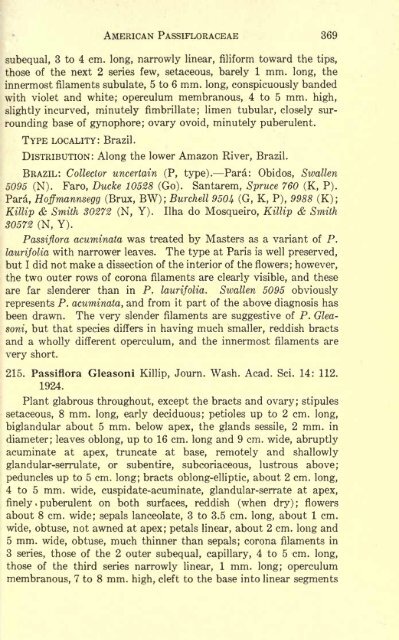downloads/Killip 2.pdf - Passion Flowers
downloads/Killip 2.pdf - Passion Flowers
downloads/Killip 2.pdf - Passion Flowers
You also want an ePaper? Increase the reach of your titles
YUMPU automatically turns print PDFs into web optimized ePapers that Google loves.
AMERICAN PASSIFLORACEAE 369<br />
subequal, 3 to 4 cm. long, narrowly linear, filiform toward the tips,<br />
those of the next 2 series few, setaceous, barely 1 mm. long, the<br />
innermost filaments subulate, 5 to 6 mm. long, conspicuously banded<br />
with violet and white; operculum membranous, 4 to 5 mm. high,<br />
slightly incurved, minutely fimbrillate; limen tubular, closely surrounding<br />
base of gynophore; ovary ovoid, minutely puberulent.<br />
TYPE LOCALITY: Brazil.<br />
DISTRIBUTION: Along the lower Amazon River, Brazil.<br />
BRAZIL: Collector uncertain (P, type). Para: Obidos, Swallen<br />
5095 (N). Faro, Ducke 10528 (Go). Santarem, Spruce 760 (K, P).<br />
Para, Hoffmannsegg (Brux, BW); Burchell 9504 (G, K, P), 9988 (K);<br />
Kittip & Smith 30272 (N, Y). Ilha do Mosqueiro, Kittip & Smith<br />
30572 (N, Y).<br />
Passiflora acuminata was treated by Masters as a variant of P.<br />
laurifolia with narrower leaves. The type at Paris is well preserved,<br />
but I did not make a dissection of the interior of the flowers; however,<br />
the two outer rows of corona filaments are clearly visible, and these<br />
are far slenderer than in P. laurifolia. Swallen 5095 obviously<br />
represents P. acuminata, and from it part of the above diagnosis has<br />
been drawn. The very slender filaments are suggestive of P. Gleasoni,<br />
but that species differs in having much smaller, reddish bracts<br />
and a wholly different operculum, and the innermost filaments are<br />
very short.<br />
215. Passiflora Gleasoni <strong>Killip</strong>, Journ. Wash. Acad. Sci. 14: 112.<br />
1924.<br />
Plant glabrous throughout, except the bracts and ovary; stipules<br />
setaceous, 8 mm. long,<br />
early deciduous; petioles up to 2 cm. long,<br />
biglandular about 5 mm. below apex, the glands sessile, 2 mm. in<br />
diameter; leaves oblong, up to 16 cm. long and 9 cm. wide, abruptly<br />
acuminate at apex, truncate at base, remotely and shallowly<br />
glandular-serrulate, or subentire, subcoriaceous, lustrous above;<br />
peduncles up to 5 cm. long; bracts oblong-elliptic, about 2 cm. long,<br />
4 to 5 mm. wide, cuspidate-acuminate, glandular-serrate at apex,<br />
finely . puberulent on both surfaces, reddish (when dry); flowers<br />
about 8 cm. wide; sepals lanceolate, 3 to 3.5 cm. long, about 1 cm.<br />
wide, obtuse, not awned at apex; petals linear, about 2 cm. long and<br />
5 mm. wide, obtuse, much thinner than sepals; corona filaments in<br />
3 series, those of the 2 outer subequal, capillary, 4 to 5 cm. long,<br />
those of the third series narrowly linear, 1 mm. long; operculum<br />
membranous, 7 to 8 mm. high, cleft to the base into linear segments
















